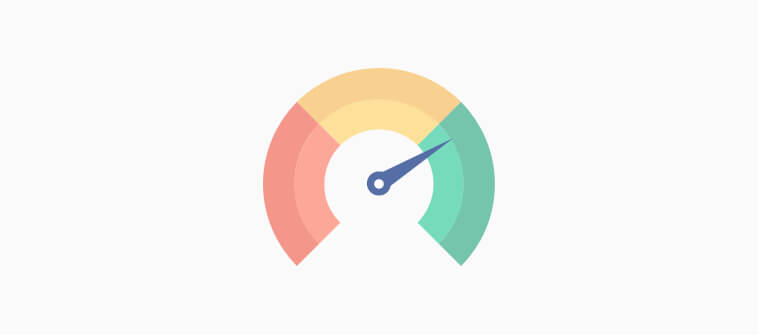![Customer Satisfaction Surveys [2023 Quick Guide with Questions]](https://www.proprofssurvey.com/blog/wp-content/uploads/2023/12/Feature_SM_Customer-Satisfaction-Surveys-2023-Quick-Guide-with-Questions.jpg)
Imagine this scenario: You have launched a new product and are confident in your creation. However, after a few weeks of sales, you notice a decline in customer interest. You don’t know what’s causing the issue, but something needs to change. Now, how do you figure out what it is?
That’s where customer satisfaction survey come in. By surveying your customers and asking for their feedback, you can gain valuable insights into your product’s likes and dislikes. From there, you can make the necessary changes to improve customer satisfaction and increase sales.
In this guide, we’ll explore the different types of CSAT surveys and their purpose in measuring customer satisfaction. We have also added ready-to-use survey templates to help you get started on your campaigns.
What Is a Customer Satisfaction (CSAT) Survey?
CSAT surveys are questionnaires designed to measure and quantify the level of satisfaction customers have with a specific brand, product, service, or interaction.
It asks the customers to rate their satisfaction on a rating scale or provide feedback on their experience. Through these surveys, you can capture valuable insights that help you fine-tune your strategies, improve customer experiences, and build stronger relationships.
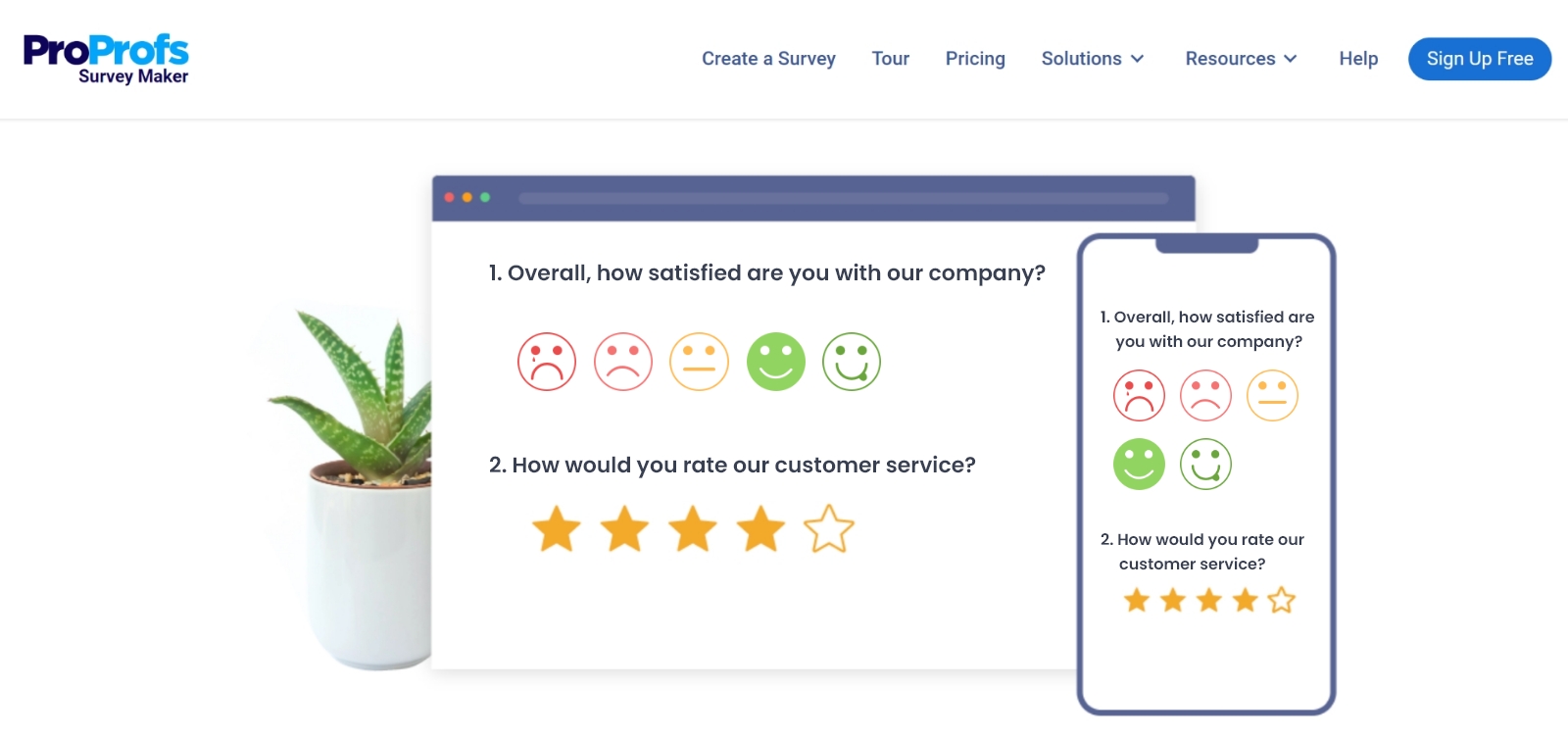
The impact of customer satisfaction on a business is huge. Studies have shown that a whopping 86% of consumers are willing to pay more for a better customer experience.
This powerful tool provides you with a structured way to measure customer satisfaction, identify areas for improvement, and gauge the overall success of your products/services.
By tapping into the thoughts and emotions of your customers, you gain a deeper understanding of what truly delights them and what may be falling short.
What Is the Use of Customer Satisfaction Survey?
When it comes to running a successful business, understanding your customers’ expectations is key. It’s tied to delivering an exceptional experience and cultivating loyal customers.
This is where customer satisfaction survey step in, allowing you to gain invaluable insights into what truly matters to your customers.
1. Meeting Customers Needs Head-On
By conducting customer satisfaction survey, you can directly connect with your target audience and delve into their wants and needs. These surveys enable you to identify the aspects that hold the most value for your customers, providing you with a clear understanding of their expectations.
Armed with this knowledge, you can align your goals and strategies to meet and even exceed these expectations, ultimately winning over your customers and fostering their loyalty.
2. Turning Feedback Insights into Growth
Today, opinions can spread like wildfire across social media platforms, so it becomes crucial to address any potential criticism before it gains momentum.
By actively seeking customer feedback through surveys, you can uncover positive and negative aspects of your offerings.
It lets you make necessary enhancements, capitalize on strengths, and transform any weaknesses into opportunities for growth.
By addressing customer concerns proactively, you can prevent negative feedback from tarnishing your brand name while leveraging positive feedback to turn satisfied customers into brand advocates.
3. Improving Customer Retention Rates
Today, customer retention is paramount when customers have numerous options to switch to a competitor easily. You demonstrate your commitment to understanding your customers’ needs by conducting customer satisfaction survey regularly.
This, in turn, makes them feel valued and appreciated, increasing the likelihood that they will remain loyal to your brand.
By consistently striving to improve your products, services, and overall customer experience based on survey feedback, you can enhance customer retention rates and foster long-term relationships.
4. Unveiling Customer Sentiments
CSAT surveys provide a direct line of communication with your customers, allowing you to uncover their sentiments, preferences, and pain points.
By gathering quantitative and qualitative feedback, you gain valuable insights into what makes your customers tick and which areas need improvement.
5. Identifying Areas for Improvement
These surveys pinpoint specific areas where your business may be falling short, enabling you to identify pain points and make necessary improvements.
Whether it’s a flaw in your product, a gap in your service, or an issue with the overall experience, You can identify and address these issues and concerns promptly.
6. Building Customer Loyalty and Advocacy
Satisfied customers are more likely to become loyal advocates for your brand, leading to positive word-of-mouth, referrals, and increased customer retention.
CSAT surveys help you identify such customers and nurture those relationships, ultimately turning them into brand ambassadors who promote your business to others.
7. Enhancing Competitive Advantage
Customer satisfaction survey enable you to stay ahead by constantly improving your products, services, and overall customer experience.
By consistently measuring customer satisfaction, you can benchmark your performance against competitors and identify areas where you excel or need to catch up.
8. Driving Business Growth
Happy customers directly impact your bottom line. Studies have shown that businesses with higher customer satisfaction levels tend to experience higher revenue growth.
CSAT surveys provide the insights to make data-driven decisions, prioritize investments, and allocate resources effectively, leading to improved business performance.
For example, if a specific channel like Live Chat has a low CSAT score and you discover the reason as ‘less knowledgable staff,’ you can introduce training modules to train the agents and improve the ratings over time.
How to Measure Customer Satisfaction?
Measuring customer satisfaction involves collecting, analyzing, and interpreting the data gathered from your surveys to assess how satisfied your customers are with your products, services, or overall experience.
Here’s a step-by-step guide on effectively measuring customer satisfaction:
1. Define Your Objectives
Clearly outline what you want to achieve with the survey. Are you looking to assess overall satisfaction, identify specific areas for improvement, or track changes over time?
2. Set Benchmarks
Establish benchmarks or performance targets based on historical data or industry standards. Comparing your current satisfaction scores to these benchmarks can help you gauge your performance.
3. Design the Survey
Create a well-structured survey with clear and concise questions. Use a mix of question types, including multiple-choice, scale-based, and open-ended questions.
4. Collect Responses
Determine how you will distribute the survey. Common methods include email, in-app surveys, website pop-ups, or paper surveys. Ensure the survey is easily accessible to your target audience.
5. Analyze the Data
Once you’ve collected responses, it’s time to analyze the data. Here’s how to do it:
- Quantitative Data Analysis: For closed-ended questions (e.g., rating scales), calculate averages, percentages, and other relevant metrics. This provides a numerical snapshot of satisfaction levels.
- Qualitative Data Analysis: For open-ended questions, categorize and analyze the written responses to identify common themes, issues, or suggestions.
6. Calculate Customer Satisfaction Scores
Use metrics like Net Promoter Score (NPS), Customer Satisfaction Score (CSAT), or Customer Effort Score (CES) to quantify overall satisfaction. These scores offer a standardized way to measure and compare satisfaction over time or across different segments of customers.
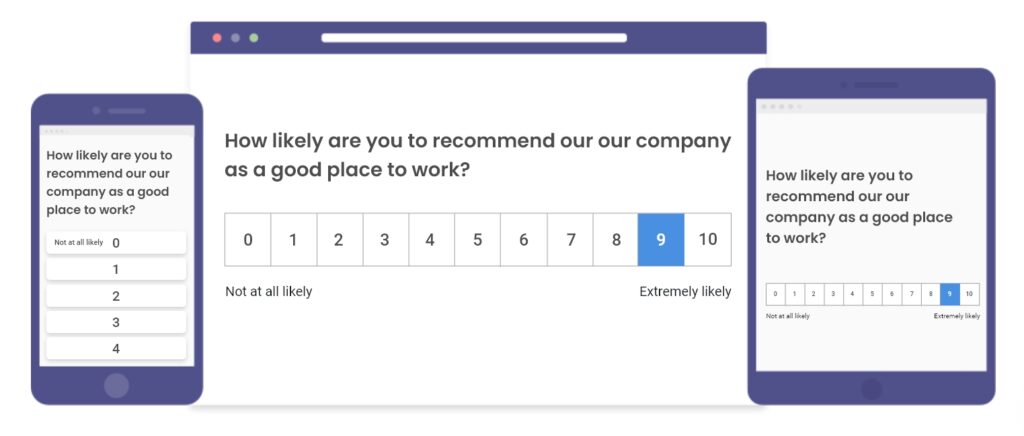
7. Segment Your Data
Divide your customer data into segments, such as demographics, product usage, or customer journey stage. This helps you understand which customer groups are more or less satisfied and tailor your actions accordingly.
8. Compare Findings With the Benchmarks
Interpret the survey findings in the context of your objectives. What do the results mean for your business? What actions should you take based on the feedback? These questions would guide the next plan of action for your business.
Types of Questions to Be Asked In Customer Satisfaction Surveys
When conducting customer satisfaction surveys, it’s essential to ask the right questions to gather meaningful insights.
Here are six types of questions you can use, along with examples:
1. Multiple Choice Question
These questions provide respondents with predefined answer options to choose from. They are useful for gathering quantitative data and making it easier for respondents to provide a quick and straightforward response.
For example, this is what ProProfs Survey Maker’s MCQ panel looks like
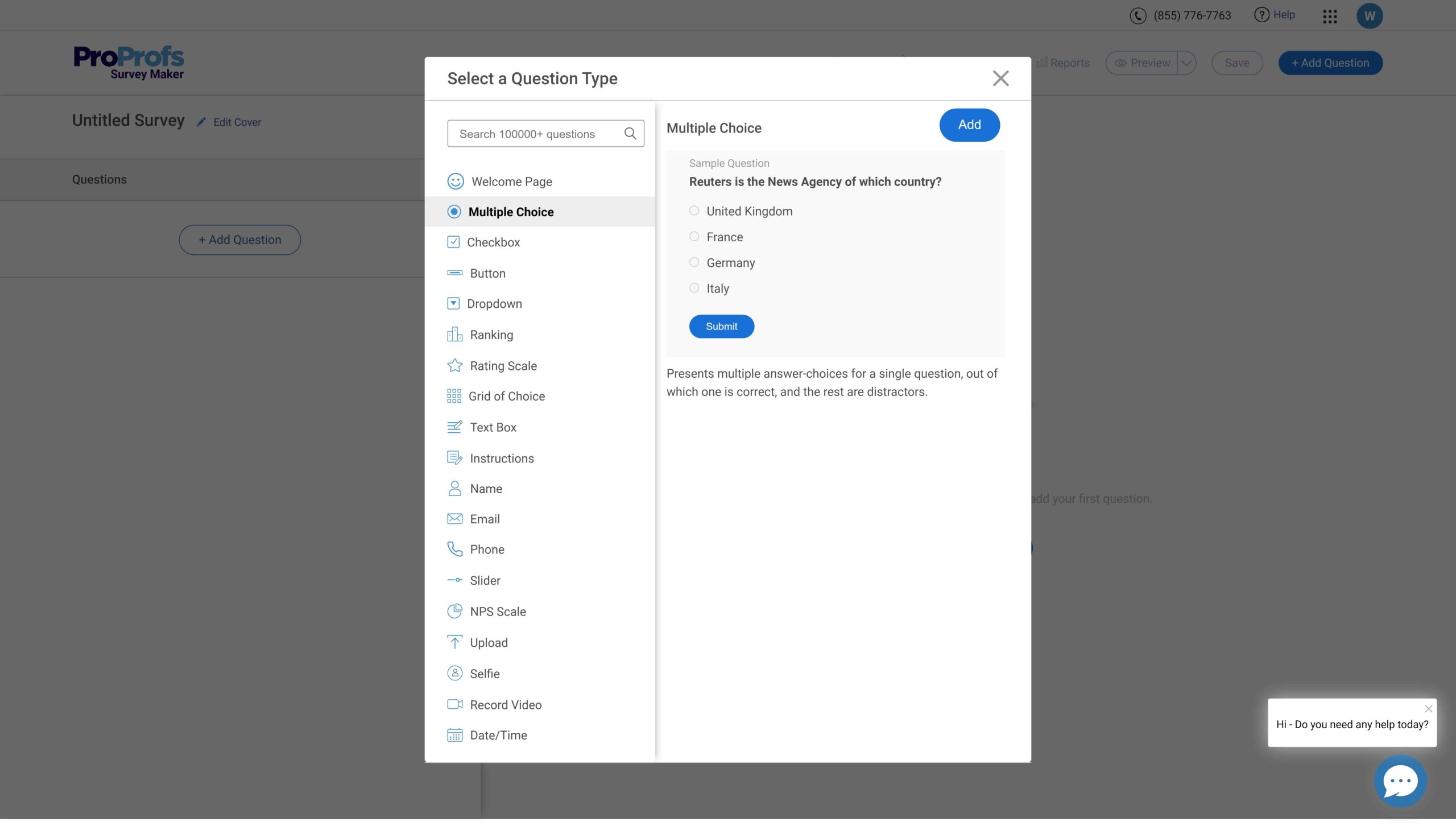
2. Rating Scale Questions
These questions use a scale, typically from 1 to 5, or emojis to measure customer satisfaction or agreement. Respondents select a number that best represents their opinion or level of satisfaction. This survey type is useful in quantifying responses and comparing satisfaction levels across different aspects.
Example:
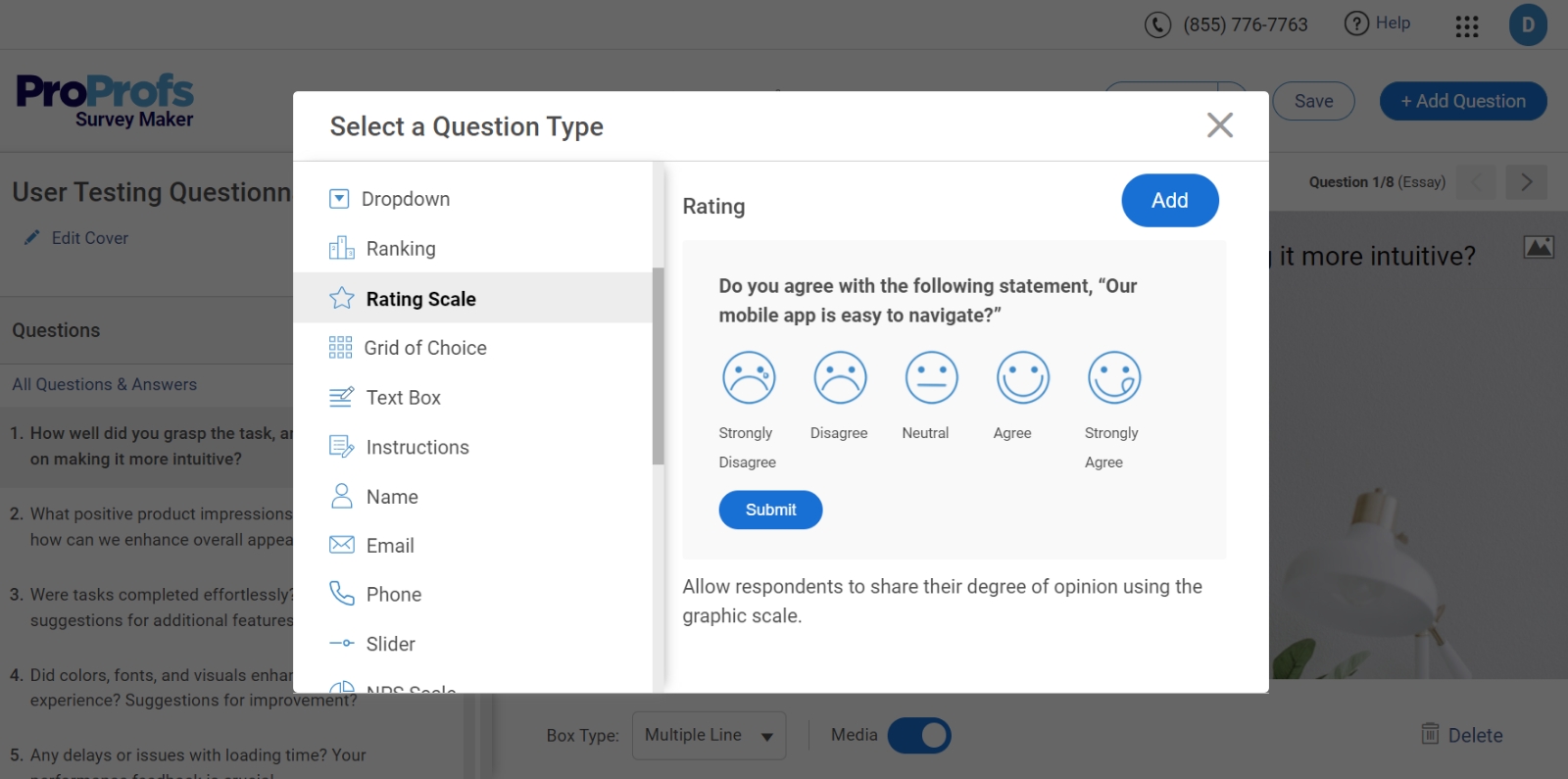
3. Open-Ended Questions
These questions allow customers to provide detailed, free-form feedback in their own words. They encourage respondents to express their thoughts, suggestions, or concerns without constraints. Open-ended questions provide valuable qualitative data and deeper insights into customer experiences.
Example:
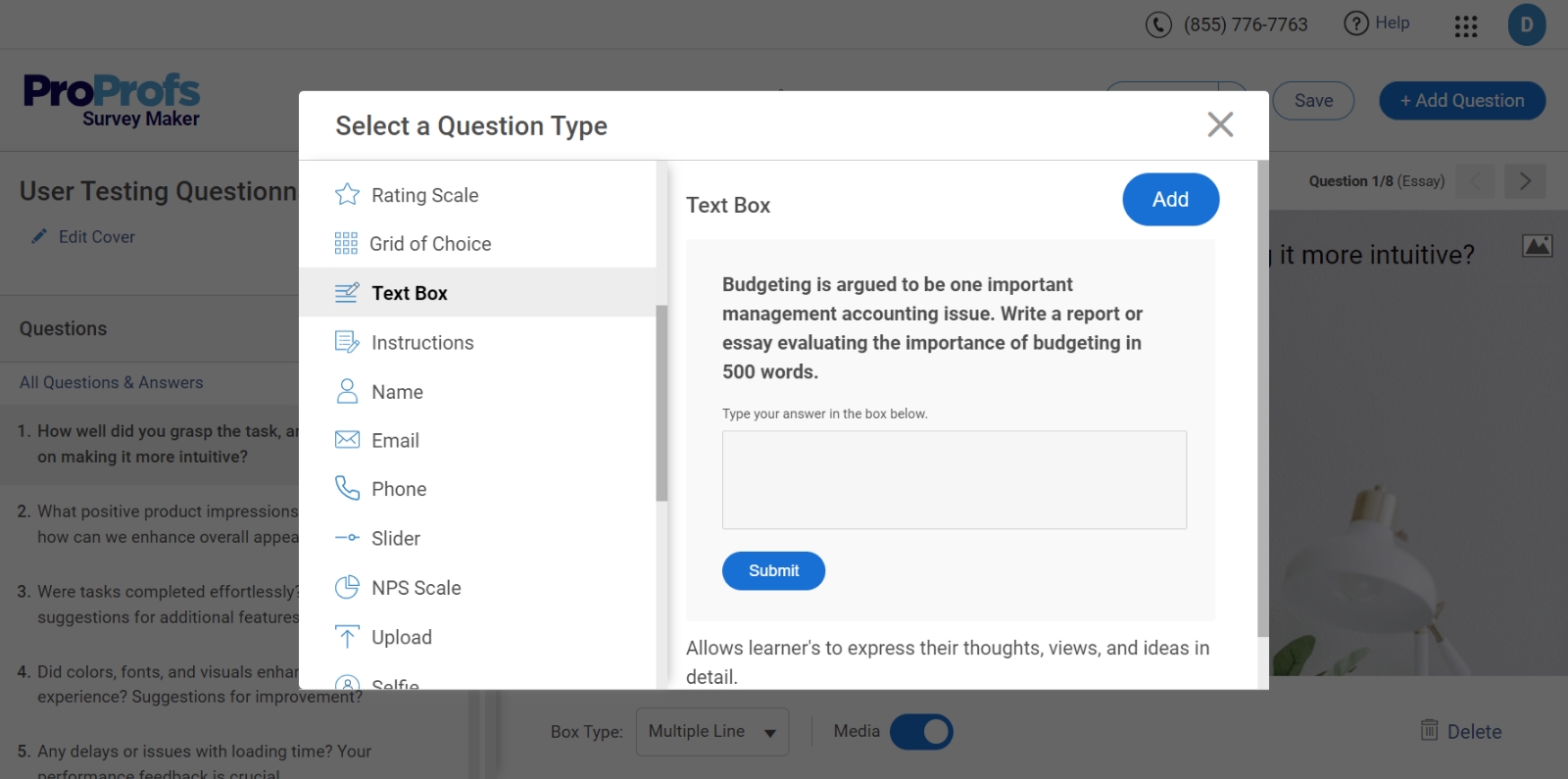
4. Likert Scale Questions
Likert scale questions measure the level of agreement or disagreement with a statement. Respondents select a level of agreement on a scale, typically ranging from “strongly agree” to “strongly disagree” or “very satisfied” to “very dissatisfied.”
Example:
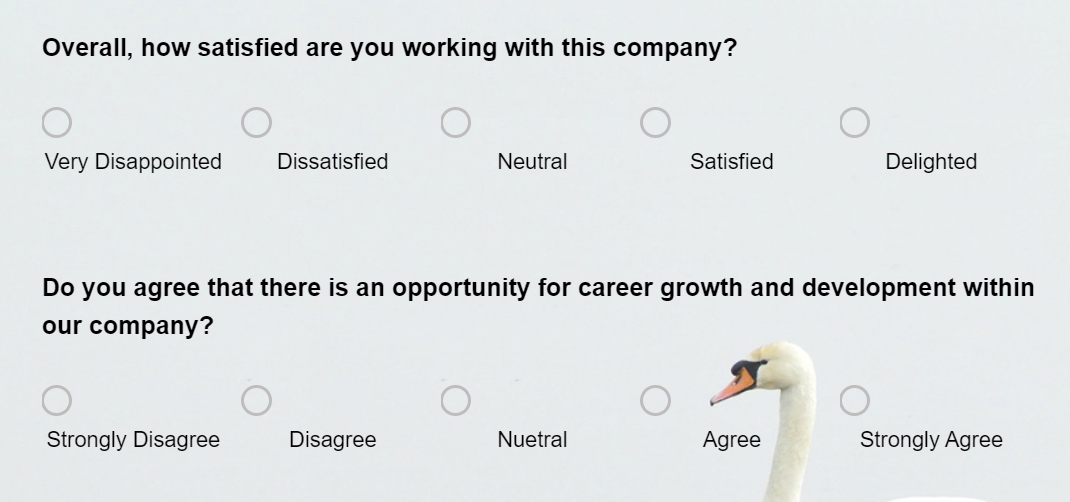
5. Binary Questions
Binary questions in a survey are questions that offer respondents only two response options, typically “yes” or “no,” or “true” or “false.” These questions require respondents to choose one of the two options that align with their opinion or preference.
They are often used to measure agreement, disagreement, or confirmation of a particular statement or condition.
Example:
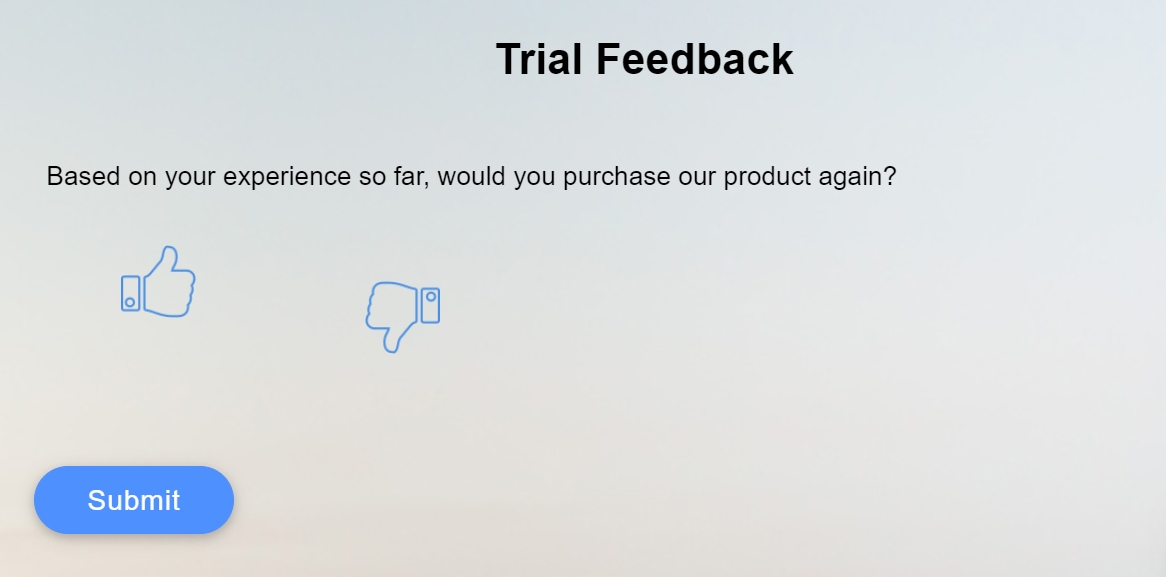
6. Net Promoter Score (NPS) Questions
NPS questions assess customer loyalty and likelihood to recommend a product or service. Respondents are asked to rate their likelihood of recommending on a scale from 0 to 10.
NPS categorizes respondents into Promoters (9-10), Passives (7-8), and Detractors (0-6) to calculate a single score.
This question type is particularly useful for tracking customer loyalty and identifying potential brand advocates.
Example:
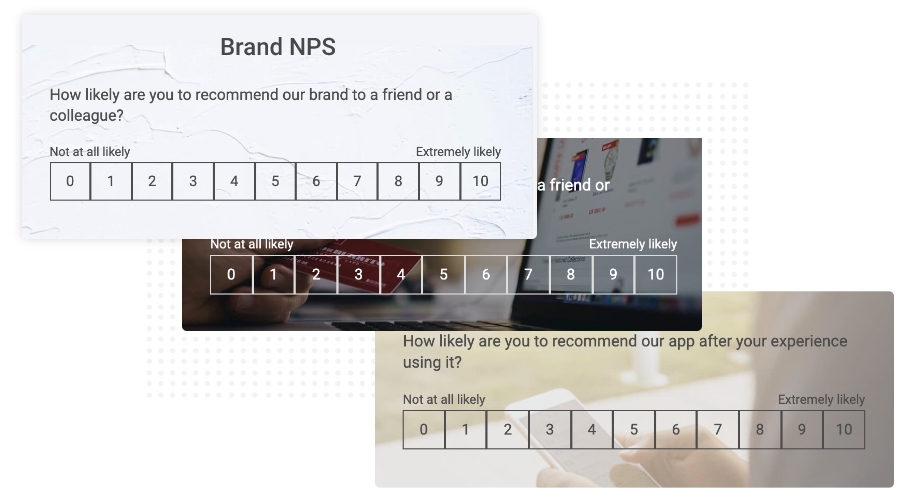
FREE. All Features. FOREVER!
Try our Forever FREE account with all premium features!
How to Work On The Insights You Get From A CSAT Survey?
Let’s say you have distributed your survey and received the results. What next? To turn your data into actionable insights, you must follow some crucial steps, such as:
1. Analyze the Results
- Carefully review and analyze the survey responses to identify patterns, trends, and areas for improvement.
- Categorize the respondents into different groups based on their CX scores and lifetime value. It will help you prioritize high-value, unsatisfied customers and address their concerns first.
- Analuze the open-ended responses to spot common themes like product bugs and prioritize areas that require immediate attention based on customer feedback.
2. Share Findings with the Team
- Share the survey findings and insights with relevant departments or teams within your organization.
- Collaborate to develop action plans and implement necessary changes based on customer feedback.
3. Follow-Up with Dissatisfied Customers
- Next, reach out to customers who expressed dissatisfaction to understand their concerns in more detail.
- Offer personalized solutions or compensation to turn the frown upside down and improve their overall customer experience.
4. Appreciate Positive Feedback
- Respond to customers who provided positive feedback, expressing gratitude for their support.
- Acknowledge their positive experiences and encourage them to share their satisfaction with others.
5. Implement Improvements
- Use the survey insights to drive improvements in products, services, or processes.
- Incorporate customer suggestions and address identified pain points to enhance the overall customer experience.
6. Communicate Changes to Customers
- Inform customers about the improvements or changes made as a result of their feedback.
- Demonstrate that their opinions were valued and their feedback has led to tangible improvements.
7. Maintain a Feedback Loop
- Establish a continuous feedback loop with customers to gather insights on an ongoing basis.
- Regularly solicit feedback and make it easy for customers to provide suggestions or voice their concerns.
5 Readymade Customer Satisfaction Survey Templates To Get Started
To make it easier for businesses to create a customer satisfaction survey, we will provide five templates that they can use to get started.
1. Customer Loyalty Survey Template
This survey template is fit for collecting insights on how likely your customers are to remain loyal to your brand, whether they will act as promoters, remain passive, or detract from your brand value.
The template contains 10 questions related to product/service experience, frequency of purchase, reason for dissatisfaction, if any, and more.
You can easily customize and tailor them to your needs for collecting targeted feedback.
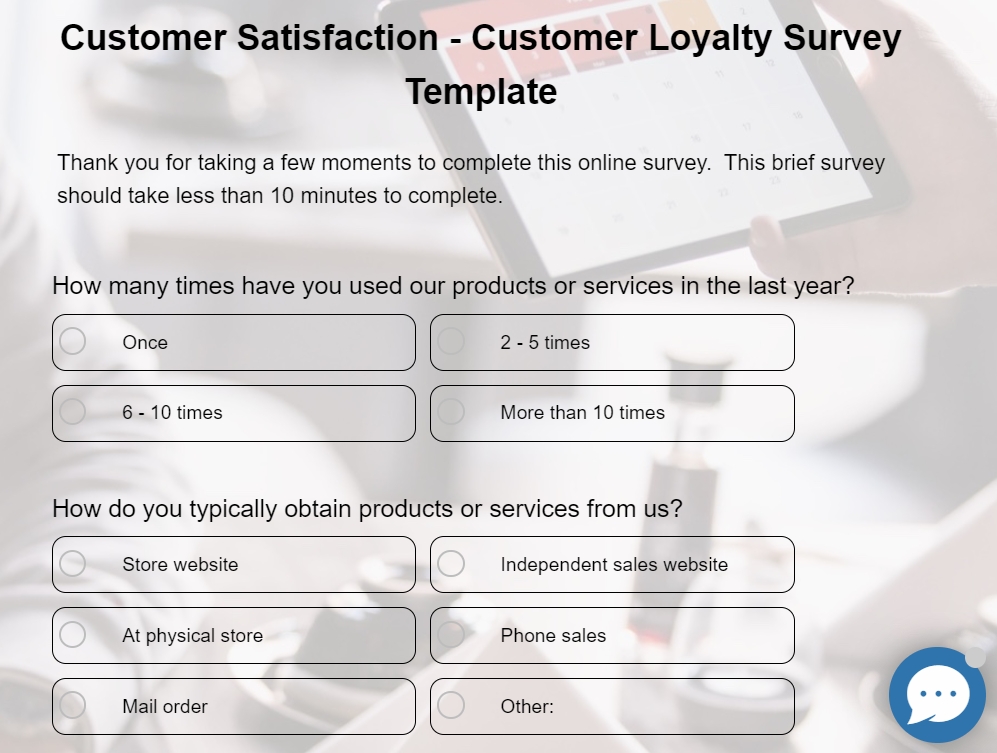
2. Customer Service Net Promoter Score (NPS) Template
This is a standard NPS template helpful for collecting feedback on your customer service team. It contains a single question that asks the customers to rate the service interaction on a scale of 0-10.
Based on the answers, you can segregate the responses to identify at-risk customers and unsatisfied customers and take necessary action.
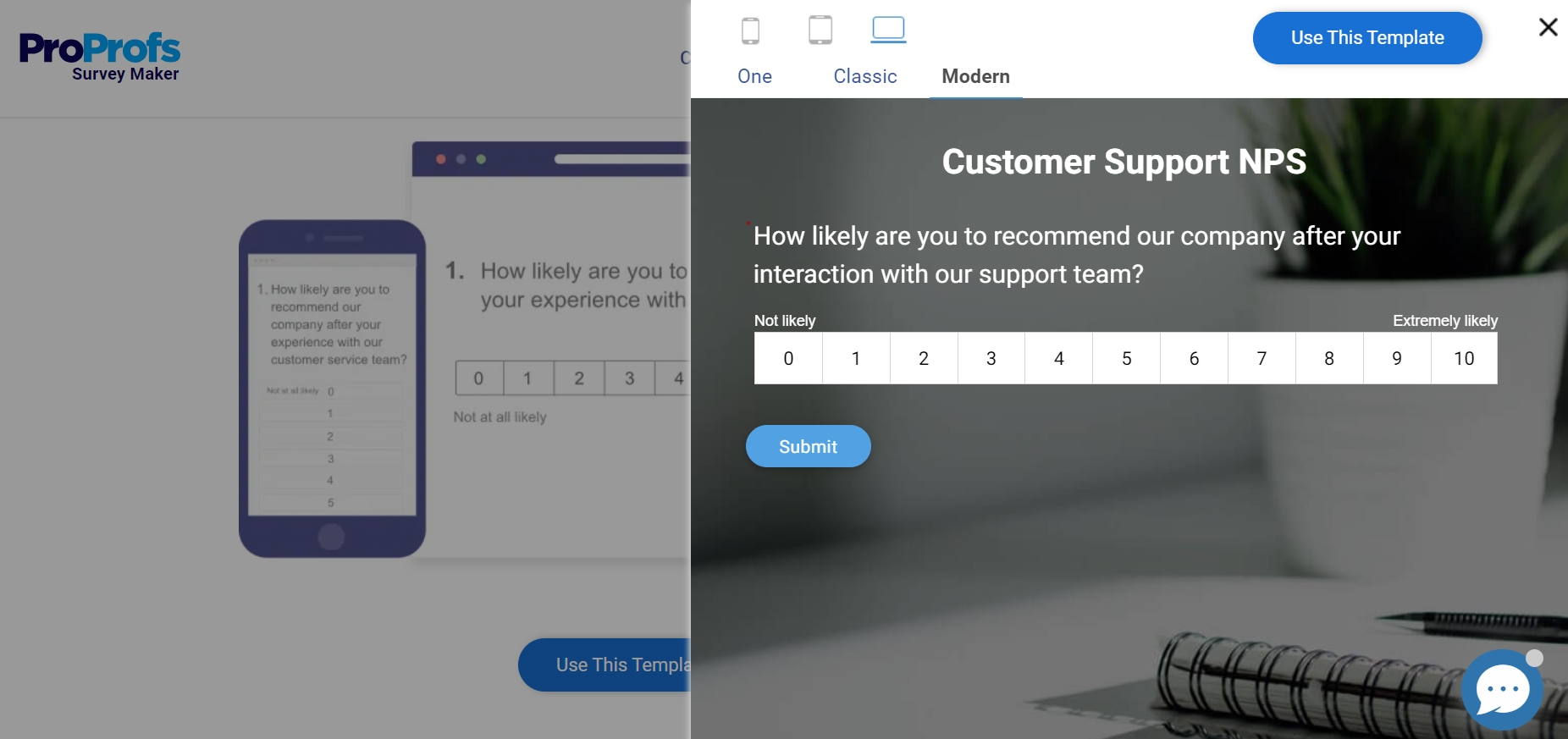
3. Product Satisfaction Survey
As the name suggests, this template collects customer ratings about your product.
You can add more questions to it to explore different product aspects like quality, value for money, durability, etc., based on the product type and required feedback.
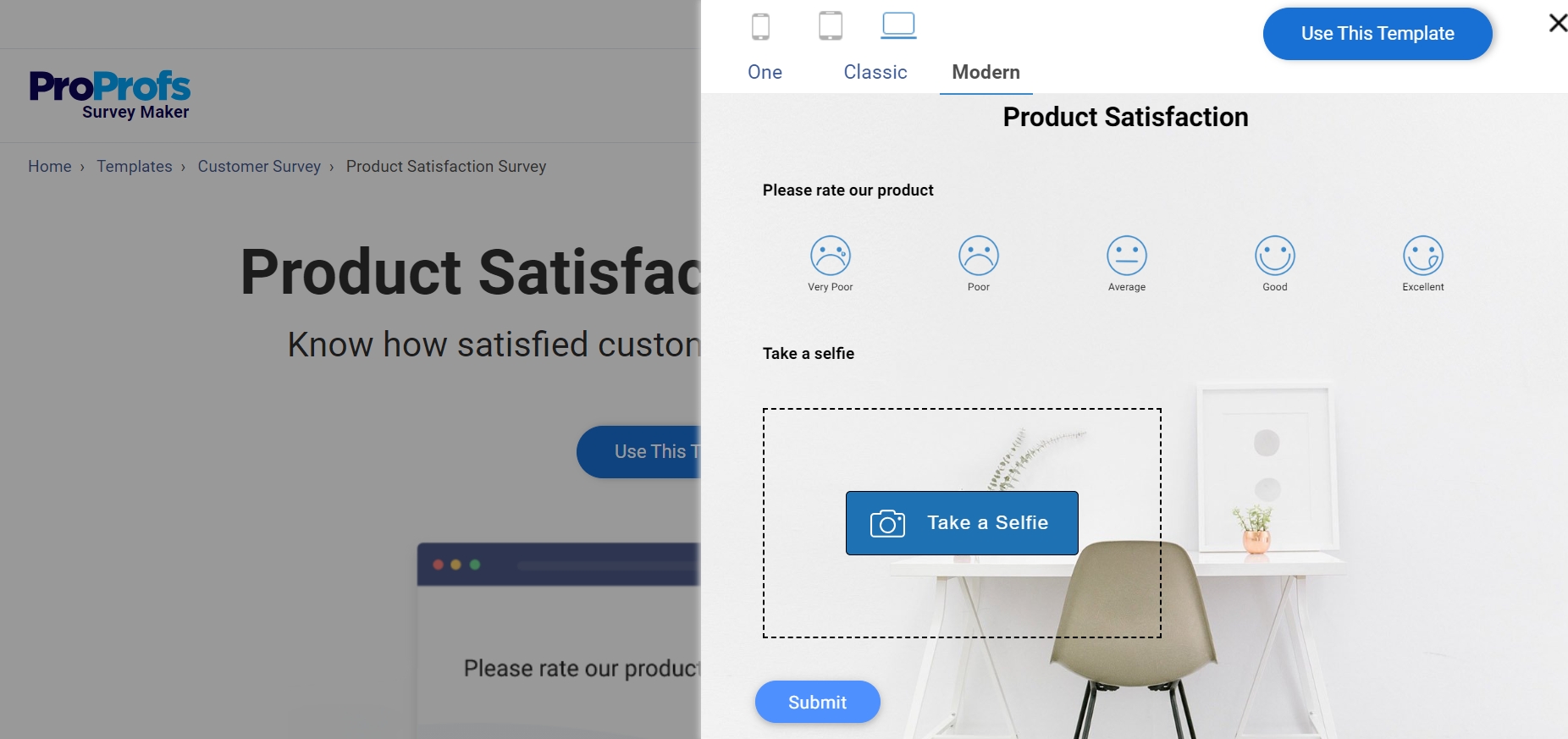
4. Website Satisfaction Template
If you want to target on-site visitors and gain insights about your website, this is the customer satisfaction survey template to go for.
This survey template asks a variety of questions about different website attributes like layout, design, content quality, and ease of navigation. It gives a complete overview of visitors’ experience on your website and provides actionable insights on how you can improve it.
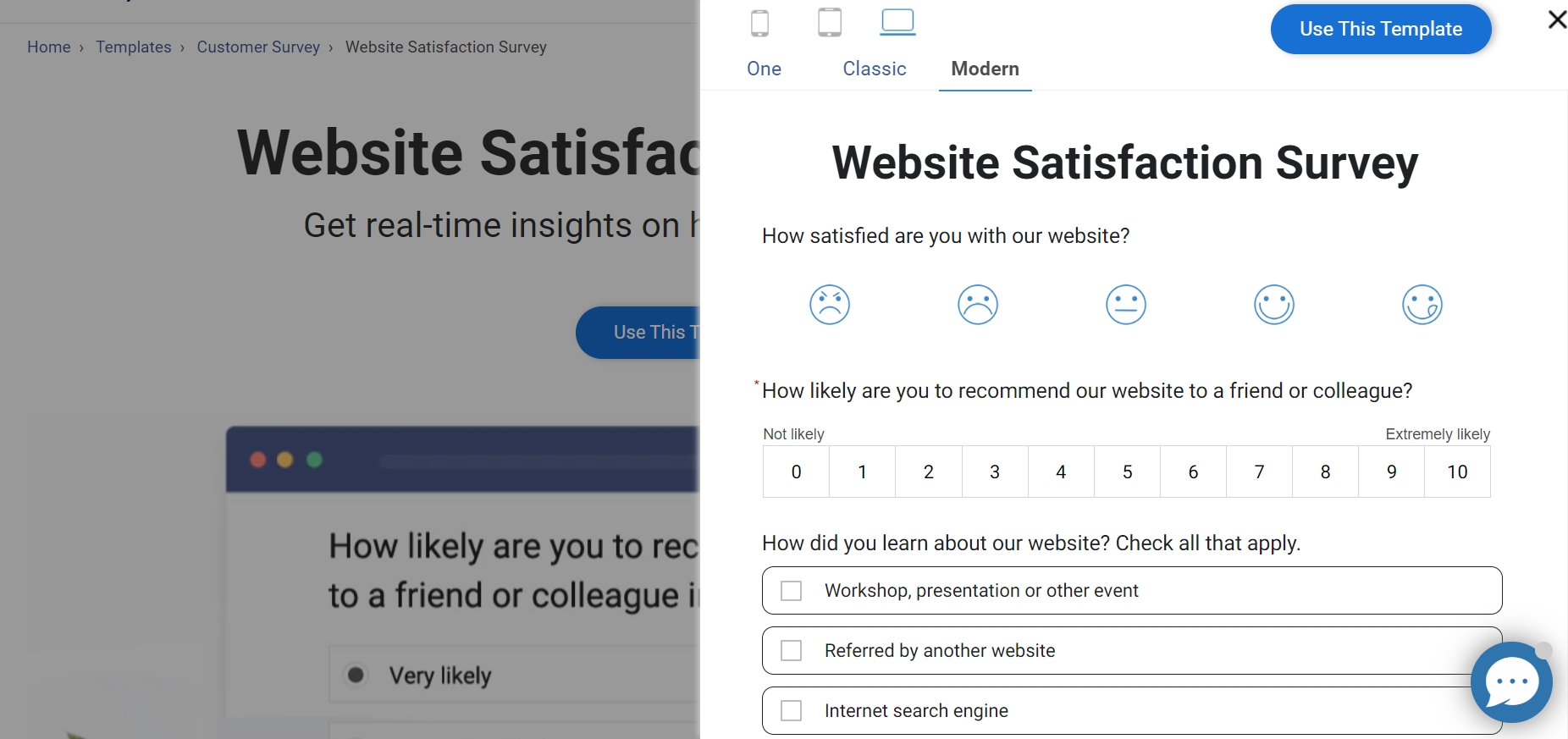
5. Client Satisfaction Survey Template
You can use this template to target regular product users or long-term clients. The template is tailored to measure the customers’ perception of your products and services.
It also explores the likelihood of brand advocacy and how you stand out from the competition. As always, you can customize the questions and theme to make it your own.
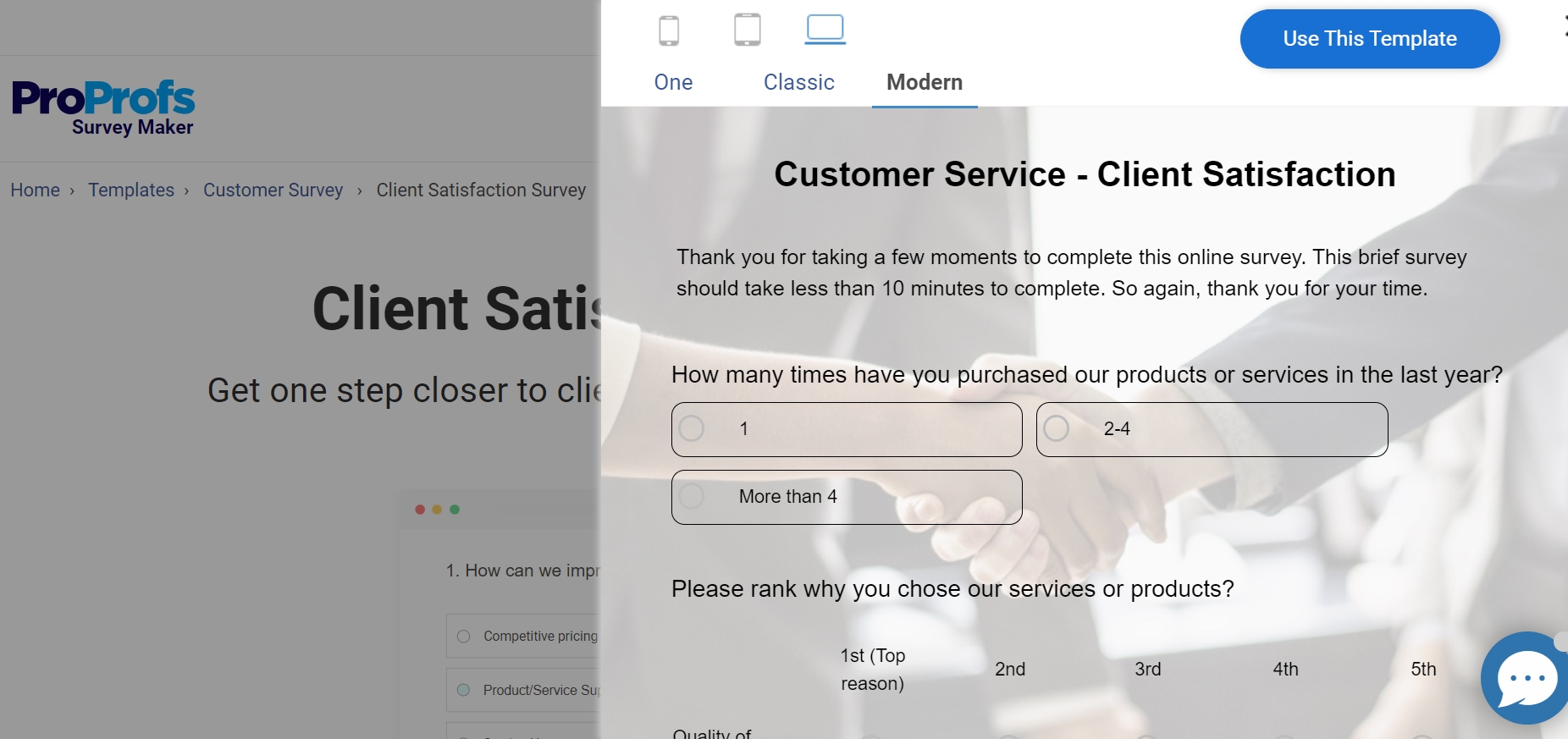
Harness the Power of CSAT Surveys for Business Growth
In the words of customer service expert Shep Hyken – ‘Every company’s greatest assets are its customers because, without customers, there is no company’.
In today’s highly competitive business landscape, understanding and satisfying your customers’ needs are paramount to achieving long-term success. Customer satisfaction surveys serve as a powerful tool to unlock valuable insights, enabling you to meet and exceed customer expectations.
Start by creating small CSAT survey campaigns, and collect feedback from your customers. Analyze the feedback and refine the survey to make it more potent.
Once you have the customer feedback loop set up ay your end, you can create multiple survey campaigns to target customers’ journeys at different touchpoints and determine from the scores what areas need improvement.
Try ProProfs Survey Maker as your CSAT survey solution and watch your business thrive as you continually evolve to meet the ever-changing needs of your customers.
Frequently Asked Questions
What is a CSAT survey?
A CSAT (Customer Satisfaction) survey is a type of customer feedback survey designed to measure the level of satisfaction a customer has with a specific interaction, product, service, or overall experience.
It typically uses a rating scale, often ranging from 1 to 5 or 1 to 7, where customers indicate their level of satisfaction. CSAT surveys are commonly used by businesses to gather quantitative data on customer satisfaction and identify areas for improvement.
What are the 4 types of customer satisfaction surveys?
There are several types of customer satisfaction surveys, but four common ones include
- CSAT (Customer Satisfaction) Survey: Measures satisfaction with a specific interaction or experience, usually with a rating scale question like, “How satisfied are you with your recent purchase/service experience?”
- NPS (Net Promoter Score) Survey: Assesses overall loyalty by asking customers how likely they are to recommend a product or service to others, typically on a scale from 0 to 10.
- CES (Customer Effort Score) Survey: Focuses on the ease of completing a specific task or resolving an issue, often using a question like, “How easy was it to resolve your issue today?”
- Overall Satisfaction Survey: Evaluates overall satisfaction with a brand, product, or service without specifying a particular interaction. It can use a variety of question formats.
What is an example of a CSAT question?
A typical CSAT question might look like this:
“On a scale of 1 to 5, with 1 being very dissatisfied and 5 being very satisfied, how satisfied are you with your recent experience with our customer support team?”
In this example, customers choose a number on the scale that best reflects their level of satisfaction with the specific interaction they had with the customer support team.
What are the most common CSAT questions?
Common CSAT questions typically ask customers to rate their satisfaction using a numerical scale. Here are some examples:
- “How satisfied are you with your recent purchase?”
- “Please rate your satisfaction with our service on a scale of 1 to 5.”
- “On a scale of 1 to 7, how satisfied are you with your experience today?”
- “How would you rate your overall satisfaction with our product?”
These questions can be customized to suit your specific business needs, but they all aim to measure customer satisfaction with a particular aspect of your business, whether it’s a product, service, or interaction.
 Tips
Tips
We’d love to hear your tips & suggestions on this article!
FREE. All Features. FOREVER!
Try our Forever FREE account with all premium features!


 We'd love your feedback!
We'd love your feedback! Thanks for your feedback!
Thanks for your feedback!



